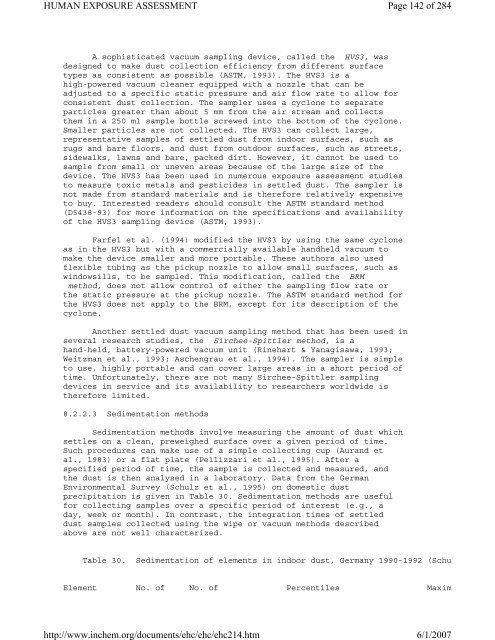Environmental Health Criteria 214
Environmental Health Criteria 214
Environmental Health Criteria 214
Create successful ePaper yourself
Turn your PDF publications into a flip-book with our unique Google optimized e-Paper software.
HUMAN EXPOSURE ASSESSMENT<br />
A sophisticated vacuum sampling device, called the HVS3, was<br />
designed to make dust collection efficiency from different surface<br />
types as consistent as possible (ASTM, 1993). The HVS3 is a<br />
high-powered vacuum cleaner equipped with a nozzle that can be<br />
adjusted to a specific static pressure and air flow rate to allow for<br />
consistent dust collection. The sampler uses a cyclone to separate<br />
particles greater than about 5 mm from the air stream and collects<br />
them in a 250 ml sample bottle screwed into the bottom of the cyclone.<br />
Smaller particles are not collected. The HVS3 can collect large,<br />
representative samples of settled dust from indoor surfaces, such as<br />
rugs and bare floors, and dust from outdoor surfaces, such as streets,<br />
sidewalks, lawns and bare, packed dirt. However, it cannot be used to<br />
sample from small or uneven areas because of the large size of the<br />
device. The HVS3 has been used in numerous exposure assessment studies<br />
to measure toxic metals and pesticides in settled dust. The sampler is<br />
not made from standard materials and is therefore relatively expensive<br />
to buy. Interested readers should consult the ASTM standard method<br />
(D5438-93) for more information on the specifications and availability<br />
of the HVS3 sampling device (ASTM, 1993).<br />
Farfel et al. (1994) modified the HVS3 by using the same cyclone<br />
as in the HVS3 but with a commercially available handheld vacuum to<br />
make the device smaller and more portable. These authors also used<br />
flexible tubing as the pickup nozzle to allow small surfaces, such as<br />
windowsills, to be sampled. This modification, called the BRM<br />
method, does not allow control of either the sampling flow rate or<br />
the static pressure at the pickup nozzle. The ASTM standard method for<br />
the HVS3 does not apply to the BRM, except for its description of the<br />
cyclone.<br />
Another settled dust vacuum sampling method that has been used in<br />
several research studies, the Sirchee-Spittler method, is a<br />
hand-held, battery-powered vacuum unit (Rinehart & Yanagisawa, 1993;<br />
Weitzman et al., 1993; Aschengrau et al., 1994). The sampler is simple<br />
to use, highly portable and can cover large areas in a short period of<br />
time. Unfortunately, there are not many Sirchee-Spittler sampling<br />
devices in service and its availability to researchers worldwide is<br />
therefore limited.<br />
8.2.2.3 Sedimentation methods<br />
Sedimentation methods involve measuring the amount of dust which<br />
settles on a clean, preweighed surface over a given period of time.<br />
Such procedures can make use of a simple collecting cup (Aurand et<br />
al., 1983) or a flat plate (Pellizzari et al., 1995). After a<br />
specified period of time, the sample is collected and measured, and<br />
the dust is then analysed in a laboratory. Data from the German<br />
<strong>Environmental</strong> Survey (Schulz et al., 1995) on domestic dust<br />
precipitation is given in Table 30. Sedimentation methods are useful<br />
for collecting samples over a specific period of interest (e.g., a<br />
day, week or month). In contrast, the integration times of settled<br />
dust samples collected using the wipe or vacuum methods described<br />
above are not well characterized.<br />
Page 142 of 284<br />
Table 30. Sedimentation of elements in indoor dust, Germany 1990-1992 (Schu<br />
Element No. of No. of Percentiles Maxim<br />
http://www.inchem.org/documents/ehc/ehc/ehc<strong>214</strong>.htm<br />
6/1/2007

















